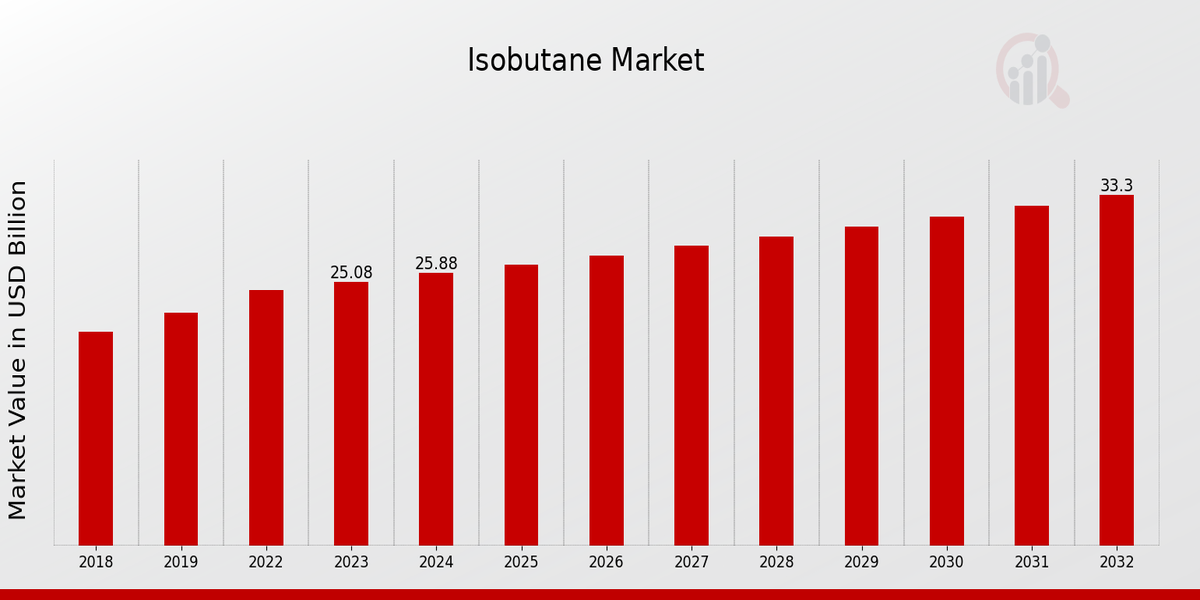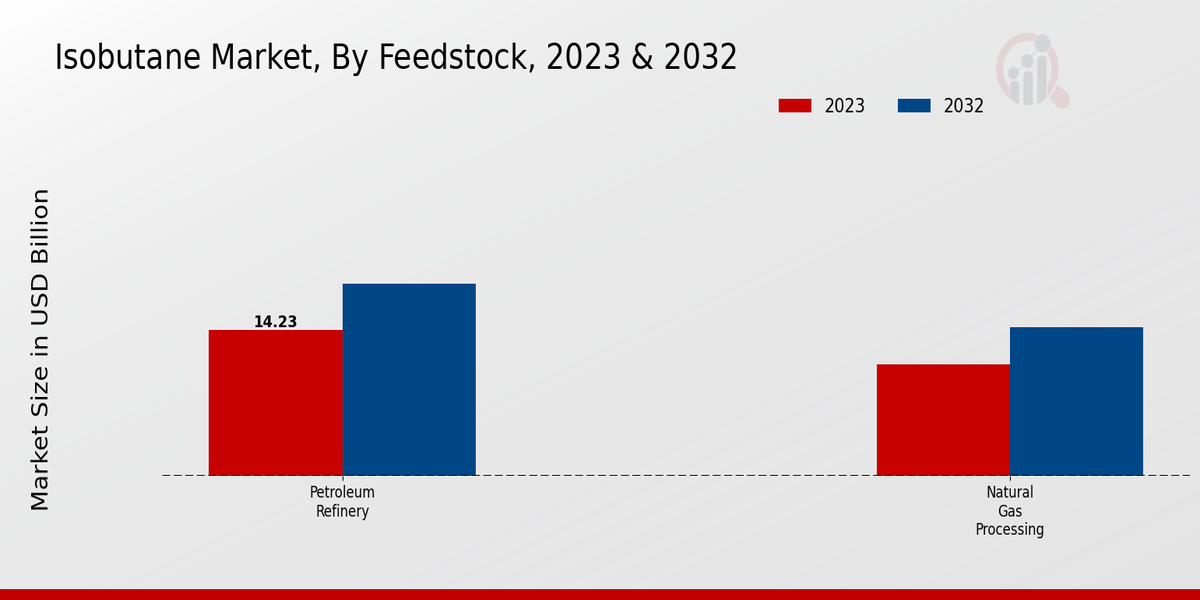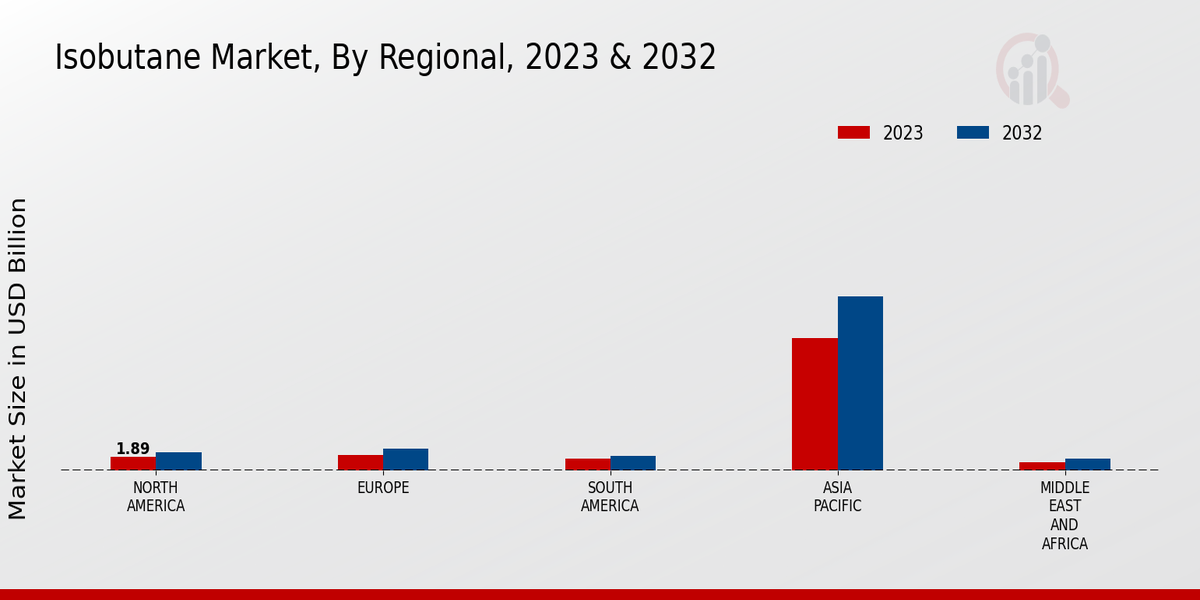Global Isobutane Market Overview
Isobutane Market Size was estimated at 26.72 (USD Billion) in 2024. The Isobutane Industry is expected to grow from 27.58 (USD Billion) in 2025 to 36.69 (USD Billion) by 2034. The Isobutane Market CAGR (growth rate) is expected to be around 3.2% during the forecast period (2025 - 2034).
Key Isobutane Market Trends Highlighted
The key market drivers for isobutane are its growing demand in the manufacturing of refrigerants, propellants, and chemicals. The rising use of isobutane as a clean and efficient fuel in automotive and industrial applications is also contributing to its market growth. Moreover, the increasing awareness about environmental sustainability and the need to reduce greenhouse gas emissions are creating significant opportunities for the isobutane market.Recent trends in the isobutane market include the development of new and innovative applications for isobutane, such as its use in the production of biofuels and as a feedstock for the chemical industry. The growing adoption of isobutane as a sustainable alternative to traditional refrigerants and propellants is also driving market expansion. Furthermore, advancements in isobutane production technologies, such as the development of more efficient and cost-effective processes, are expected to further enhance the growth of the isobutane market.

Source: Primary Research, Secondary Research, MRFR Database and Analyst Review
Isobutane Market Drivers
Rising Demand for Isobutylene Derivatives
The isobutane market is primarily driven by the increasing demand for isobutylene derivatives. Isobutylene is a key raw material for the production of a wide range of products, including methyl tert-butyl ether (MTBE), polyisobutylene (PIB), and butyl rubber. These products are used in various industries, such as automotive, construction, and packaging. The growing demand for these products is expected to drive the growth of the isobutane market in the coming years. The automotive industry is a major consumer of isobutylene derivatives.MTBE is used as a gasoline additive to improve octane ratings and reduce emissions. PIB is used in the production of tires, hoses, and other automotive components. Butyl rubber is used in the production of inner tubes and tire sidewalls. The increasing demand for automobiles, particularly in emerging markets, is expected to drive the demand for isobutylene derivatives and, consequently, the isobutane market. The construction industry is another major consumer of isobutylene derivatives.PIB is used in the production of roofing membranes, sealants, and adhesives. Butyl rubber is used in the production of roofing membranes and pond liners. The growing demand for construction materials, particularly in developing countries, is expected to drive the demand for isobutylene derivatives and, consequently, the isobutane market.
Growing Petrochemical Industry
The growth of the petrochemical industry is another key driver of the isobutane market. Isobutane is a byproduct of the refining of crude oil and natural gas. The increasing demand for petrochemicals, such as plastics, fertilizers, and synthetic fibers, is leading to an increase in the production of isobutane. This, in turn, is expected to drive the growth of the isobutane market in the coming years. The petrochemical industry is a major consumer of isobutane.Isobutane is used as a feedstock for the production of a wide range of petrochemicals, including isobutylene, isobutene, and methyl tert-butyl ether (MTBE). These petrochemicals are used in the production of a variety of products, including plastics, fertilizers, and synthetic fibers. The growing demand for these products is expected to drive the demand for isobutane and, consequently, the isobutane market.
Increasing Environmental Regulations
Increasing environmental regulations are also driving the growth of the isobutane market. Isobutane is a relatively clean-burning fuel that produces fewer emissions than other fossil fuels. This makes it an attractive option for use in applications where emissions reduction is a priority. For example, isobutane is increasingly being used as a refrigerant in place of hydrofluorocarbons (HFCs). HFCs are potent greenhouse gases that contribute to climate change.Isobutane has a much lower warming potential than HFCs, making it a more environmentally friendly option. The growing adoption of environmental regulations is expected to drive the demand for isobutane as a clean-burning fuel and refrigerant. This, in turn, is expected to drive the growth of the isobutane market in the coming years.
Isobutane Market Segment Insights
Isobutane Market Feedstock Insights
The market is segmented based on feedstock into Petroleum Refinery and Natural Gas Processing. Petroleum Refinery is the dominant feedstock segment in the Isobutane Market, accounting for a majority of the market share. Isobutane is produced as a byproduct of crude oil refining and is typically extracted from the C4 stream during the process. The growing demand for gasoline and other refined products is expected to drive the growth of the Petroleum Refinery segment in the Isobutane Market. Additionally, the increasing use of isobutane as a feedstock for the production of high-octane gasoline and other petrochemicals is expected to further boost the demand for isobutane from petroleum refineries.Natural Gas Processing is another significant feedstock segment in the Isobutane Market. Isobutane is extracted from natural gas during the processing and separation of various hydrocarbon components. The growing demand for natural gas is expected to drive the growth of the Natural Gas Processing segment in the Isobutane Market. Additionally, the increasing use of isobutane as a feedstock for the production of isobutylene and other petrochemicals is expected to further boost the demand for isobutane from natural gas processing facilities.The Isobutane Market is expected to witness steady growth in the coming years, driven by the increasing demand for isobutane as a feedstock for the production of high-octane gasoline, isobutylene, and other petrochemicals. The growing population and the increasing demand for transportation fuels are expected to continue to drive the demand for isobutane in the long term.

Source: Primary Research, Secondary Research, MRFR Database and Analyst Review
Isobutane Market Application Insights
The Isobutane Market segmentation by Application is categorized into Fuel Blending, Refrigerant, Aerosol Propellant, and Chemical Intermediate. Among these, the Fuel Blending segment is anticipated to dominate the market, accounting for over 55% of the Isobutane Market revenue in 2023. The increasing demand for cleaner fuels and the growing adoption of isobutane as a blending component in gasoline are the key drivers of this segment's growth. The Refrigerant segment is projected to witness significant growth, owing to the increasing demand for energy-efficient and environmentally friendly refrigerants.The Aerosol Propellant segment is expected to grow steadily, driven by the rising demand for personal care and household products. The Chemical Intermediate segment is anticipated to grow at a moderate pace, supported by the increasing demand for isobutane in the production of various chemicals.
Isobutane Market End-Use Industry Insights
The Isobutane Market segmentation by End-Use Industry mainly includes Automotive, Refrigeration and Air Conditioning, Aerosols and Personal Care, and Chemical and Pharmaceutical. In 2023, the Automotive segment held the largest share of the Isobutane Market revenue, and is projected to continue its dominance throughout the forecast period. The increasing demand for isobutane as a fuel additive to enhance octane ratings and reduce emissions is driving the growth of the Isobutane Market in the automotive sector. The Refrigeration and Air Conditioning segment is also expected to witness significant growth, as isobutane is being increasingly used as a refrigerant due to its low warming potential and high energy efficiency.
Isobutane Market Purity Level Insights
The purity level segment of the Isobutane Market is categorized into 99%, 99.5%, 99.9%, and 99.99%. Among these, the 99.9% purity level segment held the largest market share in 2023, accounting for approximately 40% of the Isobutane Market revenue. This dominance is attributed to the widespread use of 99.9% pure isobutane in various applications, including automotive fuels, propellants, and refrigerants. The 99% and 99.5% purity level segments are also significant, with a combined market share of over 35% in 2023. These purity levels are commonly used in industrial applications such as chemical synthesis, extraction processes, and manufacturing.The 99.99% purity level segment, while having a smaller market share, caters to specialized applications that demand exceptionally high purity levels, such as in the electronics and pharmaceutical industries. Overall, the Isobutane Market is expected to witness steady growth in the coming years, driven by increasing demand from various end-use industries.
Isobutane Market Regional Insights
The regional segmentation of the Isobutane Market offers valuable insights into market dynamics and growth opportunities. North America holds the largest market share, driven by strong demand from the automotive and chemical sectors. Europe follows closely, with significant consumption in the automotive, construction, and pharmaceutical industries. The APAC region is expected to witness robust growth, fueled by increasing demand from China, India, and Southeast Asia. South America and MEA represent growing markets with untapped potential.These regions are witnessing increased investments in infrastructure, energy, and manufacturing, which are expected to drive isobutane demand in the coming years. The Isobutane Market is expected to continue its upward trajectory, offering significant growth opportunities for market players and investors.

Source: Primary Research, Secondary Research, MRFR Database and Analyst Review
Isobutane Market Key Players And Competitive Insights
Major players in the Isobutane Market industry are constantly striving to gain a competitive edge by investing in research and development, expanding their product portfolios, and strengthening their distribution networks. Leading Isobutane Market players are also focusing on strategic collaborations, mergers, and acquisitions to enhance their market presence and capabilities. The Isobutane Market development landscape is characterized by the entry of new players, particularly from emerging economies, which is intensifying competition. Moreover, the increasing adoption of the Isobutane Market in various end-use industries, such as automotive, paints and coatings, and pharmaceuticals, is driving market growth.A prominent player in the Isobutane Market is ExxonMobil, a energy company with a significant presence in the petrochemical industry. ExxonMobil offers a range of isobutane products, including high-purity grades for use in specialty applications. The company has a strong focus on research and development, and it is actively involved in the development of new and innovative isobutane applications. ExxonMobil's extensive distribution network and established customer base provide it with a competitive advantage in the Isobutane Market.Another key player in the Isobutane Market is SABIC, a Saudi Arabian petrochemical company. SABIC offers a wide range of isobutane products, including both standard and specialty grades. The company has a strong presence in the Asia-Pacific region, and it is expanding its operations in other emerging markets. SABIC's commitment to sustainability and its focus on developing eco-friendly products are contributing to its competitiveness in the Isobutane Market.
Key Companies in the Isobutane Market Include
- ExxonMobil
- Shell
- TotalEnergies
- Reliance Industries
- Chevron
- Saudi Aramco
- BP
- Sinopec
- Petrobras
- CNOOC
Isobutane Market Industry Developments
The isobutane market is projected to grow from USD 27.58 billion in 2025 to USD 36.69 billion by 2034, exhibiting a CAGR of 3.2% during the forecast period. Increasing demand for isobutane as a refrigerant, aerosol propellant, and feedstock for the production of high-octane gasoline is driving market growth. Furthermore, rising environmental concerns and regulations promoting the use of natural refrigerants like isobutane are expected to fuel market expansion. Key industry developments include the launch of new isobutane-based products, strategic collaborations, and investments in production capacity expansion by major players.
Isobutane Market Segmentation Insights
Isobutane Market Feedstock Outlook
- Petroleum Refinery
- Natural Gas Processing
Isobutane Market Application Outlook
- Fuel Blending
- Refrigerant
- Aerosol Propellant
- Chemical Intermediate
Isobutane Market End-Use Industry Outlook
- Automotive
- Refrigeration and Air Conditioning
- Aerosols and Personal Care
- Chemical and Pharmaceutical
Isobutane Market Purity Level Outlook
Isobutane Market Regional Outlook
- North America
- Europe
- South America
- Asia Pacific
- Middle East and Africa
| Report Attribute/Metric |
Details |
| Market Size 2024 |
26.72 (USD Billion) |
| Market Size 2025 |
27.58 (USD Billion) |
| Market Size 2034 |
36.69 (USD Billion) |
| Compound Annual Growth Rate (CAGR) |
3.2% (2025 - 2034) |
| Report Coverage |
Revenue Forecast, Competitive Landscape, Growth Factors, and Trends |
| Base Year |
2024 |
| Market Forecast Period |
2025 - 2034 |
| Historical Data |
2020 - 2024 |
| Market Forecast Units |
USD Billion |
| Key Companies Profiled |
ExxonMobil, Shell, TotalEnergies, Reliance Industries, Chevron, Saudi Aramco, BP, Sinopec, Petrobras, CNOOC |
| Segments Covered |
Feedstock, Application, End-Use Industry, Purity Level, Regional |
| Key Market Opportunities |
Growing demand for Isobutane as a clean-burning fuel in refineries Increasing use of Isobutane in the production of MTBE, a fuel additive Expanding the application of Isobutane in the pharmaceutical and cosmetic industries Rising demand for Isobutane from the aerosol propellant sector Growing awareness of the environmental benefits of Isobutane |
| Key Market Dynamics |
Growing demand for isobutane as a refrigerant Increasing use of isobutane in the production of plastics Rising consumption of isobutane in the manufacturing of pharmaceuticals Government regulations promoting the use of isobutane as a clean energy source Technological advancements in isobutane production and applications |
| Countries Covered |
North America, Europe, APAC, South America, MEA |
Frequently Asked Questions (FAQ) :
The Isobutane Market is projected to reach an overall valuation of approximately 27.58 billion USD in 2025.
The Isobutane Market is estimated to exhibit a steady Compound Annual Growth Rate (CAGR) of around 3.2% from 2025 to 2034.
By 2034, the Isobutane Market is anticipated to attain an overall valuation of approximately 36.69 billion USD.
The North America region is projected to hold the largest market share in the Isobutane Market due to increasing demand from various industries and favorable government regulations.
Isobutane has extensive applications in diverse industries, including as a refrigerant in household appliances, a feedstock in the production of isobutylene for synthetic rubber, and as a fuel in portable stoves and camping equipment.
Some of the notable competitors operating in the Isobutane Market include ExxonMobil, Royal Dutch Shell, Chevron Phillips Chemical Company, SABIC, and INEOS.
The increasing demand for Isobutane as a clean and efficient refrigerant, growing consumption in the petrochemical industry, and rising environmental concerns are key factors propelling the growth of the Isobutane Market.
The Isobutane Market faces certain challenges, such as stringent regulations regarding its use as a refrigerant, volatility in raw material prices, and competition from alternative refrigerants.
The COVID-19 pandemic had a moderate impact on the Isobutane Market. While demand from certain sectors declined, increased demand from healthcare and essential industries partially offset the losses.
The Isobutane Market is witnessing increasing adoption of Isobutane as a sustainable refrigerant, growing investments in isobutylene production, and advancements in the development of more efficient isobutane-based technologies.

















